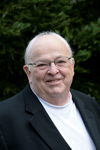

Thursday - February 26, 2009
SLAC Today is
available online at:
http://today.slac.stanford.edu
In this issue:
Data Mining Meets Black Magic
SLAC Cosmologist Awarded Sloan Research Fellowship
Stanford Pioneers in Science: Burton Richter
Changes to Employee Retirement Plans
 |
 |
|
Thursday - February 26, 2009 |
Data Mining Meets Black MagicWeinstein and Horn's new algorithm manipulates a data set
so that data points can "roll" down hills and cluster in their own valleys, creating structure.
The above plot shows one data set reduced to two dimensions to
demonstrate how most of the points in different clusters lie in separate valleys of the potential function. (Image
courtesy of Marvin Weinstein. Click for larger image.)
Whether they work in physics, biology, medicine, business intelligence or financial analysis, groups around the world are searching for hidden structures in large data sets. Deducing meaning from these sets can be very, very difficult—perhaps as difficult as, say, quantum mechanics. Now, using the advanced mathematics of particle physics, SLAC theorist Marvin Weinstein and Tel Aviv University theorist David Horn have created a completely new method by which large data sets can be mined for structure and specific information. "When you're recording tons of data, knowing how the things you measure relate to what you actually want to know gets complicated," Weinstein said. "I originally developed the quantum mechanics techniques used in the data mining algorithm as a way to better understand complex relationships in quantum mechanics, quantum chemistry and field theory. The application to data mining was a bonus." Read more... SLAC Cosmologist Awarded Sloan Research FellowshipKavli Institute for Particle Astrophysics and Cosmology physicist Chao-Lin Kuo has been awarded a Sloan Research Fellowship. Kuo is one of the 118 early-career scientists, mathematicians and economists in the United States and Canada to receive $50,000 in research grants over the next two years. "It's an honor," Kuo said, "not just because of the cash prize, but because of its history and the people who were awarded this fellowship in the past." Since the first grants were awarded in 1955, 38 Sloan Research Fellows have gone on to win the Nobel Prize in their fields. Kuo studies the origins of the universe and develops technology to examine the cosmic microwave background. The grant has the unique advantage of being unrestricted, meaning promising scholars like Kuo can use it to explore lines of research they wouldn't be able to pursue under their main grants. "I can use this funding to do research in other directions," Kuo said. "I've had some good ideas recently, so I think the timing of this award was very good." The award had good timing for another reason—just days after learning the news, Kuo and his wife welcomed a son into their family. "I think there's more work involved in a baby," Kuo said. "But it's exciting." Read more in the Stanford news release. Stanford Pioneers in Science: Burton Richter Burton Richter.
(Photo by Diana Rogers.) Next Wednesday evening, Nobelist and SLAC Director Emeritus Burton Richter will be honored in the Stanford Pioneers in Science event series. Interviewer Paul Costello will talk with Richter about his professional accomplishments, values and advice for aspiring scientists. SLAC Director Persis Drell will launch the event with an introduction to Richter's distinguished career. The Stanford Pioneers in Science series, now in its inaugural year, celebrates the lives and contributions of Stanford faculty members who have been awarded Nobel Prizes, National Medals of Science or Technology and MacArthur Fellowships. All are welcome attend the event, at Cubberley Auditorium in Stanford's School of Education, March 4 at 7:30 p.m. The event is free and open to the public. For more information, see the event announcement. Changes to Employee Retirement PlansStanford Benefits has announced several changes that will be introduced toward the end of the year to the retirement savings programs for employees—the Tax Deferred Annuity and the Stanford Contributory Retirement Plan. The changes are intended to simplify the decision-making process when selecting investment options and provide more transparency in regard to investment management and administrative fees. The restructuring also will provide access to an expanded set of investment options. In light of recent changes in the legal and regulatory environment, the university reviewed its current investment options and redesigned the lineup, according Diane Peck, vice president of human resources. "Although we have completed the planning process for the investment fund lineup, we are working with our investment providers to assure a smooth implementation. This is why we are announcing our investment changes several months in advance of actual implementation," Peck stated in a letter mailed to employees earlier this month. Read more in the Stanford Report. |
Events
Access (see all)Announcements
|
|
| | ||
|
|
||
 <%
Response.AddHeader "Last-modified", getArticleDate()
'Response.AddHeader "Last-modified","Mon, 01 Sep 1997 01:03:33 GMT"
'Monday, December 06, 2010
%>
<%
Response.AddHeader "Last-modified", getArticleDate()
'Response.AddHeader "Last-modified","Mon, 01 Sep 1997 01:03:33 GMT"
'Monday, December 06, 2010
%>View online at http://today.slac.stanford.edu/. |
||